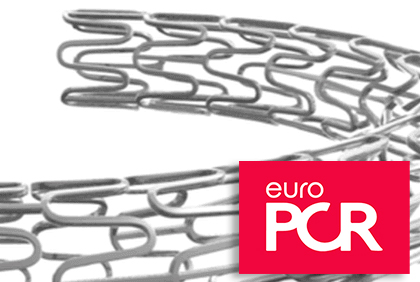Data from randomized studies are also supported by the SCAAR registry, in which ultrathin-strut stents show real-world advantages.

Patients with small vessels who received ultrathin-strut stents are less likely to undergo revascularization at 3 years than those who received first-generation thin-strut devices, according to the BIO-RESORT trial, presented during the first day of the annual PCR Congress and simultaneously published in JAMA.
Ultrathin-strut stents would offer advantages particularly in case of small vessels, due to greater relative impact of strut size and vessel lumen.
Among the 3514 patients enrolled in this three-arm trial, 1506 had at least one lesion with a reference vessel diameter <2.5 mm.
This small-vessel analysis was prespecified in the original protocol.
Beyond PCR, the Swedish registry data also suggested that ultrathin struts offer advantages, not just in small vessels, but in a broader population. Such advantage is basically driven by less revascularization.
The BIO-RESORT study enrolled patients at 4 Dutch centers between December 2012 and August 2015. Patients were randomized to receive the ultrathin sirolimus-eluting stent Orsiro (Biotronik), the very thin everolimus-eluting stent Synergy (Boston Scientific), or the zotarolimus-eluting stent Resolute Integrity (Medtronic), which have strut thicknesses of 60, 74, and 91 µm, respectively.
At 3 years, target lesion failure (defined as cardiac death, target-vessel infarction, or target-lesion revascularization) trended lower for the ultrathin-strut stent group compared with both thin-strut groups (7.0% vs. 10.0%; p = 0.08).
Considering revascularization specifically, there was a clearly significant difference in favor of ultrathin struts (2.1% vs. 5.3%; p = 0.009). That difference is only present at 2 and 3 years.
There were no disparities among the three devices as regards cardiac death, target-vessel infarction, and stent thrombosis.
Original Title: Outcomes in patients treated with thin-strut, very thin-strut, or ultrathin-strut drug-eluting stents in small coronary vessels: a prespecified analysis of the randomized BIO-RESORT trial.
Reference: Buiten RA et al. JAMA Cardiol. 2019; Epub ahead of print.
Subscribe to our weekly newsletter
Get the latest scientific articles on interventional cardiology
We are interested in your opinion. Please, leave your comments, thoughts, questions, etc., below. They will be most welcome.




